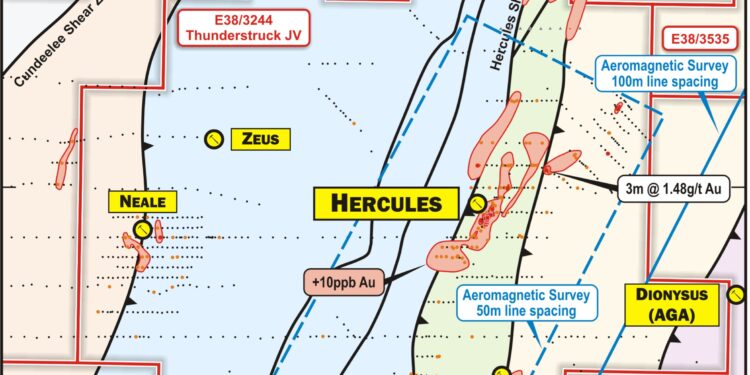Extends High-Grade Mineralisation To 250m Below Surface At Tropicana North
Gold and base metals explorer Carawine Resources Limited (ASX:CWX) has extended the high-grade vein mineralisation to 250m below surface with the latest assay results from its ongoing drill-out of the Hercules prospect at its Tropicana North Project in Western Australia.
“Hercules continues to deliver high gold grades at depth with this latest round of results extending mineralisation from 35m below surface to over 250m below surface, an extension of about 50m from previous drilling,” Managing Director, David Boyd, said.
“We’re also highly encouraged by the intersection of laminated sulphidic quartz veins and structures in surrounding drill holes and are looking forward to receiving those assay results over the coming weeks.
“Similar laminated sulphidic quartz veins have also been intersected about 50m north of the previously reported interval of 5m @ 13.1g/t Au in TNRC010, meaning Hercules is still very much open for further growth, with plenty of results and drilling yet to come.
“While Carawine is active at Hercules, drilling is also progressing at two of our Western Australian exploration joint venture properties with Rio Tinto Exploration drilling gold and copper targets at Red Dog in the Paterson region, and IGO Ltd targeting two bedrock conductors for nickel-copper sulphides at Red Bull in the Fraser Range.”
Hercules is an advanced gold prospect held by Carawine’s Thunderstruck Joint Venture (Carawine 90% interest), and forms part of the company’s large Tropicana North Project located in the north-eastern goldfields of Western Australia.
Gold mineralisation at Hercules is hosted by multiple parallel veins and shears within a wide mineralised zone striking northeast and dipping steeply to the southeast. To date, significant mineralisation has been reported along a 340m strike length, extending from 35m to 250m below surface, and remains open.
The current drilling programme at Hercules comprises 33 planned holes, of which 22 have been completed to date (12 RC and ten diamond holes). This programme follows the exceptional high-grade results returned from Carawine’s first round of exploration drilling at Tropicana North and is focussed on defining and extending gold mineralisation along strike and at depth.
Significant intervals (>0.3g/t Au cut off) returned from diamond drill holes TNDD003, TNDD004 and TNDD005 and RC drill hole TNRC035 are as follows:
- 0.6m @ 11.2g/t Au from 281.4m (TNDD005), and 1m @ 0.36g/t Au from 164m
- 1m @ 1.57g/t Au from 293m (TNDD003)
- 1m @ 0.89g/t Au from 143m (TNDD004)
- 1m @ 0.50g/t Au from 134m (TNRC035)
The interval reported from 281.4m in TNDD005 is associated with a laminated quartz-sulphide vein within a quartz veined, strongly chlorite and biotite-altered shear zone extending from 281.4m to 285.7m downhole. This demonstrates the potential for gold mineralisation to continue across substantial widths beyond TNDD005.
Immediately along strike and up-dip from TNDD005, diamond drill holes TNDD006, TNDD008 and TNDD009 have each intersected laminated sulphidic quartz veins at targeted depths, and TNDD007 has intersected an altered, veined, quartz-sulphide breccia.
This continuity and predictability of structure and veining demonstrates the potential for the Hercules system to extend beyond TNDD005. Assay results are required to confirm this potential and are expected over coming weeks.
A repeat fire-assay of the same sample as the 0.6m interval in TNDD005 returned a value of 15.3g/t Au, and a screen-fire assay on a separate sub-sample from the same interval returned a value of 12.4g/t Au
This shows that the reported gold grade can vary depending on sub-sample and assay method, which is typical of this deposit style, highlighting the importance of recognising the presence of sheared, laminated quartz – sulphide veins as well as assay data in identifying and defining the limits of mineralisation at Hercules.
For further information please visit: http://www.carawine.com.au












